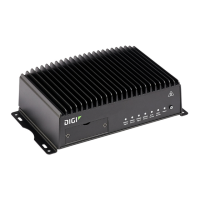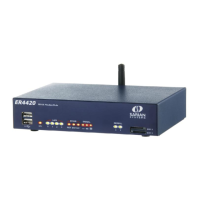TransPort
®
WR41 Utility Installation Guide
Page 18
7.2.1.1 CDMA Provisioning
CDMA provisioning is different from GSM since CDMA (in most cases) does not use a SIM card.
The CDMA modem provisioning process creates a CDMA data connection to the mobile carrier network. This
authenticates the modem and retrieves account information which is written to ash memory on the modem
module itself, not the Digi’s conguration le. As the mobile account information is stored on the CDMA module,
performing a factory reset on the unit will not remove provisioning information from the CDMA module.
Important points:
• The modem must be provisioned on the network before it will communicate.
• The modem must be in coverage area of the native carrier. It cannot be roaming.
• There must be sufcient signal strength available to provision the modem.
• Always use MIP Prole 1 for manual provisioning unless specied otherwise by your carrier or Digi
Technical Support.
7.2.1.2 Automatic vs. Manual Provisioning
There are two types of CDMA provisioning: Automatic and Manual. This varies between carriers and even
within carriers. Settings in the Web Interface vary based on carrier plan. Below are examples for Verizon
Wireless and Sprint:
Verizon Wireless always uses Automatic. This means that no further settings are required in the Web Interface
- simply press Start in the Automatic section and leave the elds blank.
Sprint has two types of plans, Vision for standard Internet connections and DataLink for private IP plans:
1. Sprint Vision uses Automatic provisioning. There are three elds of information that may need to be
populated in the Automatic screen. Check with Sprint for correct values (if required).
2. Sprint DataLink requires Manual provisioning. The required elds in the Web Interface vary based on plan
and type of embedded modem. As noted above, always use MIP Prole 1 unless otherwise specied by
your carrier or Digi Technical Support.
Check with your carrier for information about the type of provisioning required and what, if any, data is required
to be entered.
For more information on conguring the unit, please refer to the Digi TransPort User Guide which is available
at www.digi.com.
7.2.2 Cellular: GSM
To congure the Wireless WAN/mobile interface on non-CDMA routers (GPRS/UMTS/HSPA), please refer to
the Application Guide “QN02 - Congure the wireless WAN (PPP) interface” which can be found on the Digi
Support site (http://www.digi.com/support/).
It is also essential to congure a dead link detection mechanism for routers using a Wireless WAN/mobile
interface (such as GPRS/HSDPA/CDMA). Please refer to the Application Guide “AN07 - Wireless - Wide Area
Network (W-WAN) Problem Detection and Recovery” which can also be found on the Digi Support site (http://
www.digi.com/support/).

